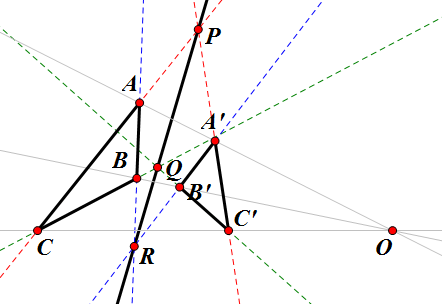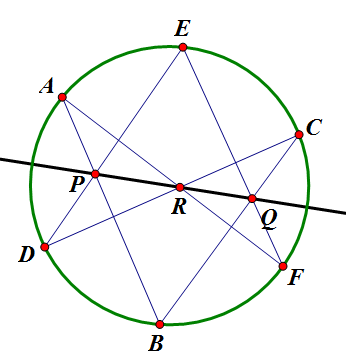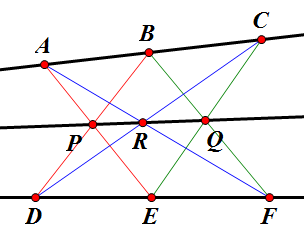Collinearity, Colinearity
개요[편집 | 원본 편집]
평면, 혹은 임의의 n차원 하이퍼스페이스에 존재하는 점들이 한 직선 위에 존재하면, 그 점들을 공선점이라 부른다. 영어로는 "Collinearity"라고 하며, "Colinearity"(l이 하나)로 써도 맞는 표현으로 취급한다. 어떤 점들이 공선점인지 밝혀내는 것은 평면기하학의 핵심이며, 공원점과 함께 수학 경시대회 기하학 파트의 필수요소.
증명 방법[편집 | 원본 편집]
당연하지만 수학에서는 "그려봤는데 한 직선 위에 있더라"같은 논리는 통하지 않는다. 직접 그려서 확인하는 것은 공선점이라고 추측할 수 있는 단서가 되지만, 실제로 공선점임을 보이기 위해서는 수학적인 방법을 사용해야 한다. 이 문단에서는 특별한 말이 없는 한, 세 점 [math]\displaystyle{ A,P,B }[/math]가 공선점임을 보일 수 있는 방법을 소개한다.
기본[편집 | 원본 편집]
1. [math]\displaystyle{ \angle{APB}=180^\circ }[/math]: 각도가 평각이면 곧 직선임을 의미하므로 세 점은 공선점이 된다. 보통 제일 첫번째로 시도하는 방법이다. 다만 [math]\displaystyle{ \angle{APB}=180^\circ }[/math]을 바로 보이기는 힘드므로 어떤 점 [math]\displaystyle{ C }[/math]를 기준으로 하여 [math]\displaystyle{ \angle{APC}+\angle{BPC}=180^\circ }[/math]를 보이게 된다.
2. 맞꼭지각: 위 1번 방법과 근본적으로는 같은 방법. [math]\displaystyle{ C,P,D }[/math]가 공선점임을 알고 있을 때, [math]\displaystyle{ \angle{APC}=\angle{BPD},\,\angle{APD}=\angle{BPD} }[/math]를 보이면 된다. 두 맞꼭지각이 동시에 성립하면 직선이 되어야하기 때문.
3. 두 점이 동일함을 증명: 무슨 소리냐 하면, [math]\displaystyle{ A,P',B }[/math]가 이미 공선점임을 알고 있을 때, [math]\displaystyle{ P=P' }[/math]임을 보여 [math]\displaystyle{ A,P,B }[/math]도 공선점임을 보이는 방법이다. 대표적으로 메넬라우스의 정리의 역을 증명할 때 사용 되는 방법. 하지만 이 방법은 사용하기가 까다롭기 때문에 자주 쓰이지 않는다.
4. [math]\displaystyle{ \overline{AB}=\overline{AP}+\overline{BP} }[/math]: 삼각부등식에서 등호가 성립하려면 세 점이 공선점이어야 한다는 사실을 이용한다. 만약 세 점이 공선점이 아니면 반드시 [math]\displaystyle{ \overline{AB}\lt \overline{AP}+\overline{BP} }[/math]가 성립하게 된다.
5. 해석기하학: [math]\displaystyle{ \overline{AB} }[/math]의 방정식과 [math]\displaystyle{ P }[/math]의 좌표를 직접 구한 뒤, 직선의 방정식에 [math]\displaystyle{ P }[/math]의 좌표를 넣었을 때 성립하는지 확인한다. 해석기하학이 다 그렇듯이 노가다가 필수지만, 시간을 투자하면 확실하게 공선점인지 파악할 수 있다.
6. 벡터: 기하학의 사기 아이템, 벡터를 사용하여 공선점 여부를 파악할 수 있다. 두 벡터가 평행하고, 시점이 같다면 두 벡터의 시점과 종점은 한 직선 위에 있게 된다. 혹은 두 벡터가 평행하고, 첫번째 벡터의 종점과 두번째 벡터의 시점이 같아도 역시 공선점이 된다. 위 해석기하학적 방법과 이 방법은 일반적인 n차원에 대해서도 쉽게 쓸 수 있다는 장점이 있다. 하지만 공선점을 활용하는 문제는 거의 다 평면기하학
심화[편집 | 원본 편집]
1. 메넬라우스의 정리의 역: [math]\displaystyle{ \triangle{ABC} }[/math]와 세 점 [math]\displaystyle{ D,E,F }[/math]에 관해 [math]\displaystyle{ \frac{\overline{AF}}{\overline{FB}}\cdot\frac{\overline{BD}}{\overline{DC}}\cdot\frac{\overline{CE}}{\overline{EA}}=1 }[/math]이 성립하면, [math]\displaystyle{ D,E,F }[/math]는 공선점이다. 이걸 도대체 무슨 수로 써먹냐는 생각이 들 수 있는데, 공선점임을 증명하는 문제에 거의 반드시 사용된다고 보면 된다.
2. 메넬라우스의 정리(삼각함수)의 역: [math]\displaystyle{ \triangle{ABC} }[/math]와 세 점 [math]\displaystyle{ D,E,F }[/math]에 관해 [math]\displaystyle{ \frac{\sin{AEF}}{\sin{EFA}}\cdot\frac{\sin{DFB}}{\sin{BDF}}\cdot\frac{\sin{CDE}}{\sin{DEC}}=1 }[/math]이 성립하면, [math]\displaystyle{ D,E,F }[/math]는 공선점이다. 네?
3. 데자르그의 정리: [math]\displaystyle{ \triangle{ABC} }[/math]와 [math]\displaystyle{ \triangle{A'B'C'} }[/math]에서, 세 직선 [math]\displaystyle{ \overleftrightarrow{AA'},\overleftrightarrow{BB'},\overleftrightarrow{CC'} }[/math]가 한 점 [math]\displaystyle{ O }[/math]에서 만나고, 직선 [math]\displaystyle{ \overleftrightarrow{BC},\overleftrightarrow{B'C'} }[/math]의 교점을 [math]\displaystyle{ P }[/math], 직선 [math]\displaystyle{ \overleftrightarrow{CA},\overleftrightarrow{C'A'} }[/math]의 교점을 [math]\displaystyle{ Q }[/math], 직선 [math]\displaystyle{ \overleftrightarrow{AB},\overleftrightarrow{A'B'} }[/math]의 교점을 [math]\displaystyle{ R }[/math]이라 하면, [math]\displaystyle{ P,Q,R }[/math]는 공선점이다. 뭐라고요? 증명은 메넬라우스의 정리의 역을 사용한다. 참고로 이 정리는 삼차원 공간에 대해서도 성립한다.
4. 파스칼의 정리: [math]\displaystyle{ A,B,C,D,E,F }[/math]를 한 원 위의 점들이라 하자. 현 [math]\displaystyle{ \overline{AB},\overline{DE} }[/math]의 교점을 [math]\displaystyle{ P }[/math], 현 [math]\displaystyle{ \overline{BC},\overline{EF} }[/math]의 교점을 [math]\displaystyle{ Q }[/math], 현 [math]\displaystyle{ \overline{CD},\overline{AF} }[/math]의 교점을 [math]\displaystyle{ R }[/math]이라 하면 [math]\displaystyle{ P,Q,R }[/math]는 공선점이다. ??? 증명은 메넬라우스의 정리의 역과 방멱의 정리를 사용한다. 참고로 두 현이 평행하면 명제는 성립하지 않는다. 또한, 이 정리는 원이 아니니라 다른 이차곡선에 대해서도 성립하며, 두 현이 만나지 않는다면 연장하면 된다. 그리고 직선 [math]\displaystyle{ \overleftrightarrow{PQR} }[/math]을 파스칼 선이라 부른다.
5. 파푸스의 육각형 정리: [math]\displaystyle{ A,B,C }[/math]를 한 직선 위의 점, [math]\displaystyle{ D,E,F }[/math]를 다른 직선 위의 점들이라 하자. [math]\displaystyle{ \overline{AE},\overline{BD} }[/math]의 교점을 [math]\displaystyle{ P }[/math], [math]\displaystyle{ \overline{BF},\overline{CE} }[/math]의 교점을 [math]\displaystyle{ Q }[/math], [math]\displaystyle{ \overline{AF},\overline{CD} }[/math]의 교점을 [math]\displaystyle{ R }[/math]이라 하면, [math]\displaystyle{ P,Q,R }[/math]은 공선점이다. ????? 증명은 메넬라우스의 정리를 다섯번 쓰면 된다.
6. 심슨의 정리: [math]\displaystyle{ \triangle{ABC} }[/math]의 외접원 위의 임의의 점 [math]\displaystyle{ P }[/math]에서 세 변(혹은 그 연장선)에 내린 수선의 발을 [math]\displaystyle{ D,E,F }[/math]라 하자. 그럼 [math]\displaystyle{ D,E,F }[/math]는 공선점이다. 증명은 각도가 [math]\displaystyle{ 180^\circ }[/math]임을 보이는 것이 제일 쉽다. 메넬라우스의 정리의 역을 쓸 수도 있지만 그러면 너무 복잡해진다. 참고로 직선 [math]\displaystyle{ \overleftrightarrow{DEF} }[/math]를 점 [math]\displaystyle{ P }[/math]에 대한 심슨선이라 부르며, 보기만 해도 정신이 날아갈 듯한 3, 4, 5번 증명과는 달리 자주 쓰인다.
공선점 예시[편집 | 원본 편집]
- 한 점과, 그 점을 점대칭시킨 점과, 대칭점.
- 외심, 무게중심, 수심, 구점원의 중심. 오일러 직선이라 부른다.
- 삼각형의 한 꼭짓점, 내심, 그 꼭짓점에 대한 방심.
- 삼각형의 한 꼭짓점, 나머지 두 꼭짓점에 대한 방심.


